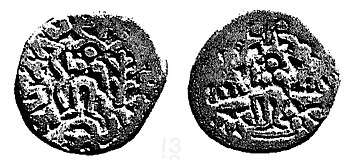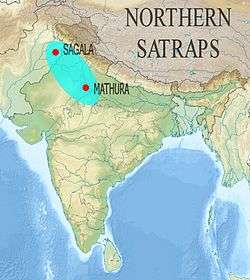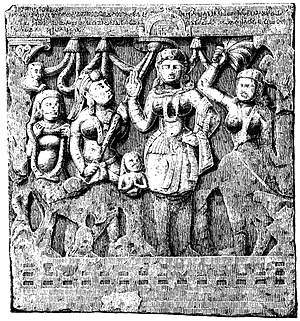Sodasa
| Sodasa | |
|---|---|
| Indo-Scythian Northern Satraps king | |
 | |
| Reign | c. 15 CE |
| Predecessor | Rajuvula |
| Father | Rajuvula |
| Mother | Kamuia Ayasa |

Obv: Lakshmi standing between two symbols on the obverse and inscription around "Mahakhatapasa putasa Khatapasa Sodasasa ".
Rev: Standing Abhiseka Lakshmi anointed by two elephants (Blurred).
Sodasa was an Indo-Scythian Northern Satrap and ruler of Mathura during the later part of the 1st century BCE or the early part of 1st century CE.[2] He was the son of the Great Satrap of Mathura Rajuvula. He is mentioned in the Mathura lion capital.
Rule
Sodasa reigned during the 1st century CE, and also took the title of Great Satrap at one point, probably in the area of Mathura as well, but possibly under the suzerainty of the Indo-Parthian king Gondophares. At the same time the Indo-Scythian Bhadayasa ruled in the eastern Punjab.[2] There were numerous cultural and political exchanges between the Indo-Scythians of the northwest and those of Mathura.[2]

Sodasa may have been a contemporary of the Western Kshatrapa Nahapana and the Indo-Parthian Gondophares.[2] The Indo-Parthians may have destabilized Indo-Scythian rule in northern India, but there are no traces of Indo-Parthian presence in Mathura.[2] Sodasa may have been displaced in Mathura by the Kushan ruler Vima Kadphises, who erected a throne in his name in Mathura, but nothing is known of these interractions.[2]
At Mathura, Sodasa is the last of the Indo-Scythians to have left coins.[2] Later, under Kanishka, son of Vima Kadphises, the Great Satrap Kharapallana and the Satrap Vanaspara are said to have ruled in Mathura with Kanishka as suzerain, pointing to continued Indo-Scythian rule under Kushan suzerainty as least until the time of Kanishka.[3][4][5][6]
Coinage
Sodasa's coins have been found in Mathura. They do not follow traditional Indo-Scythian coinage patterns, but rather the designs of local rulers of Mathura. His coins show on the obverse a standing female and tree-like symbol, with the legend Mahakatapasa putasa Khatapasa Sodasa, i.e., "Satrap Sodasa, son of the Great Satrap". On the reverse appears a Lakshmi with elephants pouring water over her.[1]
One coin type of Sodasa bears the legend "son of Rajuvula".[2]
Inscriptions
Numerous inscriptions from Mathura mentioning Sodasa's rule are known. The Mirzapur village inscription (in the vicinity of Mathura) refers to the erection of a water tank by Mulavasu and his consort Kausiki during the reign of Sodasa, assuming the title of "Svami (Lord) Mahakshatrapa (Great Satrap)".[7]
The Mathura lion capital mentions the reign of his father and predecessor Rajuvula as Mahaksatrapa while Sodasa is referred to as Ksatrapa.
A large stone slab, the Kankali Tila tablet of Sodasa, discovered in Kankali in the area of Mathura, bears a three-line epigraph mentioning that in the year 42 or 72 of "Lord Mahaksatrapa Sodasa," a monument for worship was set up by a certain Amohini.[8] A recent date for Sodasa's reign was given as 15 CE, meaning that the regnal date of the inscription would start from the Vikrama era (Bikrami calendar (starting in 57 BCE)+72=15 CE).[9][10] This would put the long reign of his father Rajuvula in the last quarter of the 1st century BCE, which is probable.[10]
Another inscription of Sodasa in Mathura records the gifts of a Brahman named Gajavara of the Segrava-gotra during the time of Saudasa the Great Satrap of the lord (paramount, whose name is lost) of tanks called Kshayawada, as well as a western tank, a well, a garden, and a pillar.[11]
- Mathura inscription mentioning the rule of Sodasa as Kshatrapa (Satrap) or Mahakshatrapa (Great Satrap).
- The Mathura lion capital mentions Sodasa as Satrap.
- Inscription of Sodasa Reign, Mirzapur village (in the vicinity of Mathura). Mathura Museum. The inscription refers to the erection of a water tank by Mulavasu and his consort Kausiki, during the reign of Sodasa, assuming the title of "Svami (Lord) Mahakshatrapa (Great Satrap)":[7][12][13]
 The Vasu Doorjamb Inscription mentionning the rule of Sodasa.
The Vasu Doorjamb Inscription mentionning the rule of Sodasa. Another inscription of Sodasa in Mathura. This inscription records the gifts of a Brahman named Gajavara of the Segrava-gotra during the time of Saudasa the Great Satrap of the lord (paramount, whose name is lost) of tanks called Kshayawada, besides a western tank, a well, a garden, and a pillar.[11]
Another inscription of Sodasa in Mathura. This inscription records the gifts of a Brahman named Gajavara of the Segrava-gotra during the time of Saudasa the Great Satrap of the lord (paramount, whose name is lost) of tanks called Kshayawada, besides a western tank, a well, a garden, and a pillar.[11] The Kankali Tila tablet of Sodasa with an inscription mentioning the year 42 or 72 during the reign of Sodasa as Makakshatrapa (Great Satrap).[8]
The Kankali Tila tablet of Sodasa with an inscription mentioning the year 42 or 72 during the reign of Sodasa as Makakshatrapa (Great Satrap).[8]
References
- 1 2 Catalogue Of The Coins In The Indian Museum Calcutta. Vol.1 by Smith, Vincent A. p.196
- 1 2 3 4 5 6 7 8 The Dynastic art of the Kushans, Rosenfield, University of California Press, 1967 p.136
- ↑ Aspects of Political Ideas and Institutions in Ancient India, Ram Sharan Sharma, Motilal Banarsidass Publ., 1991 p.295
- ↑ Ancient Indian History and Civilization, Sailendra Nath Sen New Age International, 1999, p.198
- ↑ Foreign Influence on Ancient India, Krishna Chandra Sagar, Northern Book Centre, 1992 p.167
- ↑ Source: "A Catalogue of the Indian Coins in the British Museum. Andhras etc..." Rapson, p ciii
- 1 2 Buddhist art of Mathurā , Ramesh Chandra Sharma, Agam, 1984 Page 26
- 1 2 The Jain stûpa and other antiquities of Mathurâ by Smith, Vincent Arthur Plate XIV
- ↑ Image Problems: The Origin and Development of the Buddha's Image in Early South Asia Robert Daniel DeCaroli, University of Washington Press, 2015 p.205
- 1 2 Indian Studies, Volume 7, Ramakrishna Maitra, 1966 p.67
- 1 2 Report For The Year 1871-72 Volume III, Alexander Cunningham
- ↑ History of Early Stone Sculpture at Mathura: Ca. 150 BCE - 100 CE by Sonya Rhie Quintanilla p.260
- ↑ Epigraphia Indica, Vol 40
External links
Indo-Scythian kings, territories and chronology | |||||||||||||||||||||||||||||||||||||||||||||||||||||||||||||||||||||||||||||||||||||||||||||||||||||||||||||||||||||||||||||||||||||||||||||||||||||||||||||||||||||||||||||||||||||||||||||||||||||||||||||||||||||||||||||||||||||
|---|---|---|---|---|---|---|---|---|---|---|---|---|---|---|---|---|---|---|---|---|---|---|---|---|---|---|---|---|---|---|---|---|---|---|---|---|---|---|---|---|---|---|---|---|---|---|---|---|---|---|---|---|---|---|---|---|---|---|---|---|---|---|---|---|---|---|---|---|---|---|---|---|---|---|---|---|---|---|---|---|---|---|---|---|---|---|---|---|---|---|---|---|---|---|---|---|---|---|---|---|---|---|---|---|---|---|---|---|---|---|---|---|---|---|---|---|---|---|---|---|---|---|---|---|---|---|---|---|---|---|---|---|---|---|---|---|---|---|---|---|---|---|---|---|---|---|---|---|---|---|---|---|---|---|---|---|---|---|---|---|---|---|---|---|---|---|---|---|---|---|---|---|---|---|---|---|---|---|---|---|---|---|---|---|---|---|---|---|---|---|---|---|---|---|---|---|---|---|---|---|---|---|---|---|---|---|---|---|---|---|---|---|---|---|---|---|---|---|---|---|---|---|---|---|---|---|---|---|---|
| |||||||||||||||||||||||||||||||||||||||||||||||||||||||||||||||||||||||||||||||||||||||||||||||||||||||||||||||||||||||||||||||||||||||||||||||||||||||||||||||||||||||||||||||||||||||||||||||||||||||||||||||||||||||||||||||||||||
| |||||||||||||||||||||||||||||||||||||||||||||||||||||||||||||||||||||||||||||||||||||||||||||||||||||||||||||||||||||||||||||||||||||||||||||||||||||||||||||||||||||||||||||||||||||||||||||||||||||||||||||||||||||||||||||||||||||